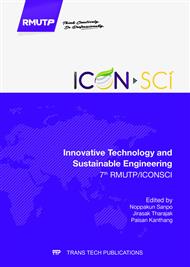[1]
A. Das, R. Alagirusamy, Science in Clothing Comfort, Woodhead Publishing India Pvt Limited, New Delhi, (2010).
Google Scholar
[2]
K.P.M. Tang, C.W. Kan, J.T. Fan, Psychological measurement of wet and clingy sensation of fabrics by the volar forearm test, Journal of Sensory Studies. 30 (2015) 329-347.
DOI: 10.1111/joss.12161
Google Scholar
[3]
K.P.M. Tang, C.W. Kan, J.T. Fan, Assessing and predicting the subjective wetness sensation of textiles: subjective and objective evaluation. Textile Research Journal. 85 (2015) 838-849.
DOI: 10.1177/0040517514555799
Google Scholar
[4]
T. Yasuda, M. Miyama, H. Yasuda, Dynamic water vapour and heat transport through layered fabrics, Part I: effect of surface modification, Textile Research Journal. 61 (1991) 10-20.
DOI: 10.1177/004051759106100102
Google Scholar
[5]
T. Yasuda, M. Miyama, H. Yasuda, Dynamic water vapour and heat transport through layered fabrics, Part II: effect of chemical nature of fibres, Textile Research Journal. 62(1992)227-235.
DOI: 10.1177/004051759206200407
Google Scholar
[6]
T. Yasuda, M. Miyama, H. Yasuda, Dynamic water vapour and heat transport through layered fabrics, Part III: surface temperature change, Textile Research Journal. 64 (1994) 457-465.
DOI: 10.1177/004051759406400805
Google Scholar
[7]
C.W. Kan, C.M.K. Ko, K. Ariyakuare, R. Mongkholrattanasit, Evaluating the warmth retention ability of polyurethane foam plying with fabrics. Abstract Book of The 7th RMUTP International Conference on Science, Technology and Innovation for Sustainable Development. Bangkok, Thailand, 23-24 June 2016, p.217.
DOI: 10.4028/www.scientific.net/amm.866.233
Google Scholar
[8]
C.W. Kan, C.M.K. Ko, W. Changmuong, R. Mongkholrattanasit, Examining the air permeability of polyurethane foam plying with fabrics. Abstract Book of The 7th RMUTP International Conference on Science, Technology and Innovation for Sustainable Development. Bangkok, Thailand, 23-24 June 2016, p.220.
DOI: 10.4028/www.scientific.net/amm.866.233
Google Scholar
[9]
C.W. Kan, C.M.K. Ko, K. Manarungwit, R. Mongkholrattanasit, Stiffness analysis of fabric-foam plied material. Abstract Book of The 7th RMUTP International Conference on Science, Technology and Innovation for Sustainable Development. Bangkok, Thailand, 23-24 June 2016, p.223.
Google Scholar
[10]
C.W. Kan, C.M.K. Ko, K. Maha-in, R. Mongkholrattanasit, Smoothness evaluation of fabric-foam plied material. Abstract Book of The 7th RMUTP International Conference on Science, Technology and Innovation for Sustainable Development. Bangkok, Thailand, 23-24 June 2016, p.209.
Google Scholar
[11]
C.W. Kan, C.M.K. Ko, C. Sarikanon, R. Mongkholrattanasit, Softness property of fabric-foam plied material. Abstract Book of The 7th RMUTP International Conference on Science, Technology and Innovation for Sustainable Development. Bangkok, Thailand, 23-24 June 2016, p.212.
Google Scholar
[12]
C.W. Kan, C.M.K. Ko, P. Numahun, R. Mongkholrattanasit, Study of drape property of fabric-foam plied material. Abstract Book of The 7th RMUTP International Conference on Science, Technology and Innovation for Sustainable Development. Bangkok, Thailand, 23-24 June 2016, p.214.
DOI: 10.4028/www.scientific.net/amm.866.224
Google Scholar


